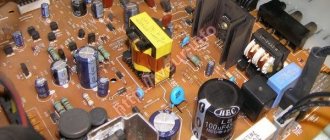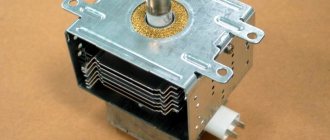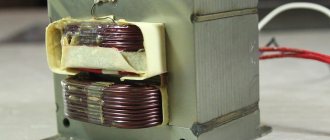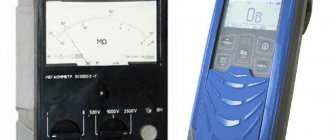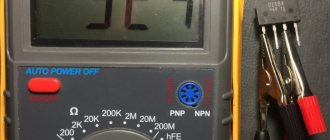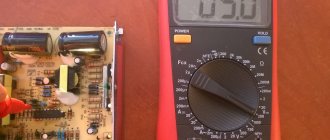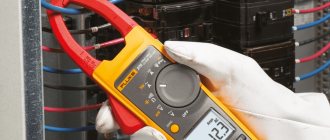RCD for water heater
An RCD is a special device that helps protect a water heater from current leaks.
The RCD looks like a small box with two lights and one button. The operating principle is as follows:
- The RCD is installed directly in front of the water heater itself; all the electric current passes through the RCD, which powers the boiler mechanism.
- As soon as a current leak occurs inside the boiler, which can become life-threatening, the RCD will detect the leak and turn off the entire system. The RCD operates using special sensors and switches.
What does an RCD look like?
Reasons for disconnecting the RCD:
- Incorrect location of the RCD. If the RCD is connected in the wrong place, then the system will conduct through itself the wrong electric current that is needed, so in the event of a breakdown, the system will not be able to protect a person from current leakage.
- The insulation of the heating element is damaged. This function protects the entire system from the passage of current through water. In old or unknown cheap models, this element can be damaged, so even with normal hand washing a person can receive an electric shock.
- Leakage current. A common reason for tripping the RCD is a broken cable or any other wire inside the boiler. In frequent cases, the cable is damaged from the inside, so the current is transferred to the boiler body, and since it is metal, the shock can be very strong when touched. In this case, you will have to check it from the inside.
It is important to install the RCD correctly, because it is what saves you from fires, explosions and other various situations that can harm others
Possible faults
Even if you regularly clean the heating element and the tank from scale, after a while the heater will be damaged, and the contacts may be exposed. This can be understood by the constantly tripping RCD, as well as tingling in the fingers when washing hands. If scale has completely covered the heating element, when the tap is open in the tank, you will hear a rumble, clicks, and a sulfur smell may appear.
A damaged heating element needs to be replaced. A heater that operates intermittently and intermittently cannot be used.
Reasons to check the heating element:
- The circuit breaker trips regularly - overload occurs due to the need to warm up the scale layer.
- If an electric current is supplied to the housing, the RCD is triggered.
- The boiler control unit is constantly switched off.
- The safety valve is malfunctioning; it is triggered and needs to be pressed.
Valera
The voice of the construction guru
Ask a Question
The magnesium anode prevents the formation of scale, which decreases over time. It is placed on the flange where the heating element is attached. The anode must be changed regularly when cleaning the boiler in order to delay breakdown of the heating element.
If your water is hard, scale will form very quickly.
Main problems with the heating tube:
- The spiral breaks. It may burn out during a short circuit in the network. The electrical circuit of the water heater opens and the unit does not work.
- Leakage of electric current to the housing (breakdown). Occurs when the insulating layer or shell is destroyed. Usually the RCD is triggered and the supply of electricity to the boiler is stopped.
- Accumulation of scale on the surface of the shell . An insoluble solid deposit may be on the tube, and if the boiler is not cleaned for a long time, the layer becomes thick. The heating element and the bottom of the tank are buried under a layer of scale.
Damage to the heating element is caused by a faulty temperature sensor in the water heater. The device does not properly control the heating of the liquid, overheating constantly occurs. Regular work in such conditions leads to destruction of the shell or the spiral itself.
They prevent breakdowns of the internal heater by installing a filter directly in front of the boiler or provide a filter system at the entrance to the home. The unit is cleaned every 6 to 12 months, making sure that the magnesium anode is changed on time as it wears out.
How to check the heating element for serviceability
Inside the heating element there is a wire spiral having a high electrical resistivity. And at the moment current is passed through it, it heats up. This helps fill the space between the spiral and the body with heat, which is why the water is heated. But sometimes heating devices stop performing their direct function, and the main reason for this is the breakdown of the heating element
Checking with a multimeter
At the initial stage, the device will need to be activated in the minimum resistance measurement mode. Then we take the ends of the device and touch them to the terminals of the component. If the spiral is broken, then the value “1” will appear on the device, which will replace the real resistance. And this is the same as endless resistance. This indicates that there is a break in the circuit, and the part must be urgently replaced.
But in situations where “0” appears on the device display, they will indicate a short circuit has occurred. And in this case, an urgent replacement of the component will also be required to resume heating the water.
It is also mandatory to check for current leakage. For these purposes, we activate the buzzer mode on the multimeter. We lean one probe against the terminal, and the second against the body of the heating element. If the buzzer makes a characteristic squeak, the part needs to be replaced.
Checking with a contact lamp
You can check the heating element without a multimeter, using a test light. This device includes two copper wires with one core. Probes are located at one end, and the opposite ends are connected to the cartridge. The latter contains a 220 V lamp, which is protected by a durable casing. If you want to make such a device, you can do it yourself, and this task will be simple even for an inexperienced craftsman.
In order to check the heating element, you will need to connect a zero from the network to the first contact, and a test lamp to the second contact. If the light comes on, then there is no break, but in the opposite situation, an urgent replacement of the part will be required.
Checking the current leakage of the heating element
First of all, the search for the cause of the malfunction must begin with checking for current leakage. Usually, if this happens, immediately when connected to the network, the RCD or differential switch is triggered and the line is de-energized.
The leak search is performed as follows:
- Unplug the electrical appliance being tested from the outlet;
- We disassemble it to gain access to the electric heater terminals;
- Turn on the dial mode on the multimeter and insert the probes into the “COM” and “VMa” connectors;
- We first ring one contact on the device body, then the other;
- Possible results:
– There is a signal , the indicator on the display is close to “0” – the heating element is faulty;
– No signal , “1” on the display – no leakage;
Unfortunately, by calling in this way, you will not always be able to detect a breakdown. Quite often, this is detected only by a specialized tester - a megohmmeter, which tests circuits with high voltage. Minor insulation damage is detected only in this way. The multimeter will only detect obvious defects, for example, when the phase conductor touches the neutral conductor.
Often, a leak can be detected by measuring the heating element when it is turned on. But I don’t recommend doing this unless you are 100% confident in your electrical skills.
If you find a leak , a connection between one of the contacts and the housing, you need to look for the location of the breakdown. I advise you to disconnect the power wires from the electric heater and take measurements without them. Then you will understand whether the heating element or other elements of the power circuit are to blame.
Checking the heating element of a water heater using a tester
There are a large number of ways. The most commonly used method is in which the test is carried out using a special tester. Before checking, you need to calculate the resistance for the installed boiler.
Formula for calculation: R=U*U/P, where:
- U - This is a constant value, equal to 220 volts.
- P - This is the power of the device; you can find it in the boiler’s instruction manual or on the factory sticker, which is located at the bottom of the boiler or on the back side.
Using a Multimeter
The multimeter has a flag that you can rotate 360 degrees and select to test any function. It needs to be turned to measure a resistance of 200 ohms. The multimeter contacts should be connected to the heating element connection. If the water heater rings, that is, it is completely working, then the same value will appear on the screen as was previously calculated using the formula.
If the display shows zero, one or an infinity sign, then this indicates some kind of breakdown, for example, a short circuit or break. In this case, you will have to change the part; repair will not work.
Failure of the heating element
Next, you need to check the boiler itself for a breakdown of the casing, this is even easier to do. The flag must be turned until the buzzer rings. The first contact of the multimeter must be connected to the tubular electric heater, and the second to the shell of the water heater or the ground terminal.
If the multimeter starts to beep, this indicates a breakdown of the housing, so in this case you should absolutely not touch the boiler itself, as an electric shock may occur, not fatal, but quite strong.
Application of a megohmmeter
Its flag must be turned towards 50 volts, one contact must be connected to the heating element contact, and the second to the body. If a value of more than 0.5 Mohm appears on the megohmmeter display, then the water heater is fully operational.
Validation Rules
Checking the heating element is not difficult, but you need to know some of the nuances of this diagnosis:
- testing is carried out only with an absolutely working multimeter,
- It is possible to accurately check the heating element only by disconnecting all connected wires,
- the joints between metal and multimeter probes must be cleaned of any dirt, rust and limescale deposits,
- The safety valve must be checked.
All these conditions are required for accurate diagnosis, so as not to mistakenly recognize a working heating element as faulty.
How to check the heating element
First you need to consider how the heating element is tested. To make it clear to you, we tried to delve into practical aspects. You can check the heating element according to the following scheme:
- Before carrying out the test, you should try to calculate the resistance. To perform the calculation, you can use the formula R=U2/P. In this formula, U will represent the voltage in your article. Indicator P is the rated power of the heating element, which can be found in the device passport.
- Before carrying out the test, the device must be disconnected from the power supply. Only after this can you start checking.
- Now turn on the multimeter in resistance test mode.
If you don't know how to use a multimeter, then don't worry. Our website already has information on how to use a multimeter correctly. If you touch the terminal with the probes, then you may encounter the following situations:
- If the value on your screen is approximately the same as in the picture, then this means that the heating element is operational.
- If "0" is displayed, then it means that the device needs to be replaced.
- The indicator “1” will mean that the network was interrupted during the test.
Also, using a multimeter, you need to check the heating element for breakdown. For this to work, the device must be switched to buzzer mode. You need to touch the terminal with one probe, and the heating element with the second. In the photo below you can see how to properly check the heating element for breakdown.
If necessary, you can also perform an insulation resistance test. This is easy to do and to do this you need to switch the device to the “500 V” range. Normal resistance will be 0.5 Mohm. Detailed information on how to check the heating element with a megohmmeter and multimeter can be seen in the video below:
Perform a visual inspection before performing the inspection. To do this, descale the device and then test the element. If you find visual damage, then the device should be replaced.
You can also check the heater for a break using an electrician's test lamp. If the light is on, then there is no break. You can make a similar lamp from scrap materials, and we have an article on how to make a control yourself. These are all ways to check the device.
In some situations, you can also test the device without a multimeter. Below you can also find videos that will help you understand how to check the heating element in a washing machine, boiler or dishwasher.
How is the resistance indicator of the heating element determined?
To check an element, it is not enough to know how and with what instruments this is done. It is necessary to have information about the value of its resistance. To begin with, it is recommended to calculate this value. To do this you will need the following information:
- Voltage supplied to the water heating element. As a rule, this indicator (U) is equal to 220 V. This voltage is present in the household electrical network of our apartments.
- The heater power indicator is R. It can be easily determined, you just need to look at the operating instructions. The second option - the power of the heating element can be checked on the Internet based on the model of the machine.
Having all the necessary information, we determine the resistance R using the special formula R=U²/P. The resulting resistance indicator is formed in the heater during operation. If the heating element is working properly, then the figure obtained by the formula will appear on the multimeter screen.
Tips: how to find out the power of a heating element
In most cases, their power is indicated on the heating elements, but there are other cases. But this is an important parameter of the device that you need to know in order to measure the resistance or replace the heater. After all, when buying a heater in a store, one of the selection criteria is power.
To determine the power of the heating element, you will need:
- Multimeter.
- The current value of the heating element during operation, obtained by measuring with a multimeter.
- Calculate the power value using the formula - current multiplied by voltage. The standard voltage for residential premises is 220V.
The final value of the heating element’s power, obtained when converting from the calculated value, is important. According to the formula, power is obtained in watts, but in electrical appliances it is indicated in kilowatts
In this simple and simple way, you can measure the power of many other electrical appliances or elements, without having any electrical engineering education at all.
Tips for extending the service life of heating elements
In order for your heater to last as long as possible, you need to follow some recommendations for operating the washing machine and then you will not be bothered by the reasons for the heater not working:
- Do not overuse washing at high temperatures. Modern washing detergents have reached a fairly high level in removing contaminants. However, they do not require high temperatures to be effective. Excessive heat treatment will not benefit your items.
- Use high-quality water for washing with the least amount of foreign impurities.
- Impurities are deposited on the parts of your machine and on your clothes.
- Wash with high quality powders. Use the right amount, do not overuse them.
- Periodically carry out preventive maintenance by cleaning the washing machine with special products.
- With this procedure, you remove accumulated scale and other deposits in your washing machine, which affect not only the service life of your assistant, but also the formation of foreign odors on clothes.
- How to remove glue from clothes
- How to wash white clothes at home
How to check the heating element in an electric kettle
Before carrying out the measuring procedure, you must first calculate the resistance that corresponds to the electrical device being measured. In this case, you should know its power. This indicator is indicated in the equipment data sheet or on the case. To calculate the resistance, you must first calculate the current passing through the heating element. This is achieved by dividing the power by the voltage of the electrical network - 220 volts.
After this, the mains voltage follows - 220 volts divided by the resulting current. This will result in a value equal to the resistance. This value should appear on the display of the measuring device as a result of diagnosing the heating device.
To examine the heating element with a tester, you need to switch the device to the resistance measurement area. Then touch the rod with one tester wire. If an incorrect value appears on the multimeter display, this indicates a break in the thread located in the middle of the tube.
The resistance in a 2000W electric kettle should correspond to a value of 25 Ohms. If there is no discrepancy inside the tube, then you need to touch the rod with one probe and the metal pipe with the other. In this case, an infinite resistance indicator should appear on the display. If the reading on the display is of a certain value, this means that a short circuit has occurred.
Private breakdowns
There are a number of typical problems that are directly related to deviations in the operation of the heating element. Among them it is necessary to highlight:
- Slow water heating. This malfunction is associated with the heating element, since there is a significant layer of scale on it. Deposits are formed due to insufficient maintenance of equipment. Scale is fossilized minerals and salts found in tap water. During use of the device, they harden and deposit on the walls, including the spiral. If the scale is not removed in time, the heating element may burn out. For the same reason, damage to the contact rods of the heating element occurs. Not everyone knows how to ring an electric kettle and determine the cause of the malfunction at home. Therefore, repairs should be entrusted to experienced professionals.
- The electric kettle turns off prematurely. The reason is quite simple - scale formed on the heating element. The heating element has a fuse that trips when it overheats. For repairs, it is necessary to clean the device from plaque.
- The kettle does not turn on due to a broken spiral thread. The breakdown occurred due to scale on the heating element or turning on the device without liquid. The spiral can also burn out due to low-quality parts that were used in the manufacture of the heating device.
How to determine resistance readings?
To check the boiler, you will need to calculate the resistance using the following algorithm, based on a school physics course.
- The network voltage is about 220 V.
- The power of the boiler is indicated in the instructions for this washing machine.
- You can calculate the resistance by dividing the square of the voltage value by the declared power. So, for a power of 1800 W, the resistance of the spiral will be 26.8 Ohms. If the device displays exactly this (or closest to it) value, then the serviceability of the heating element is obvious.
This is the working resistance of the boiler. It is this that determines the current strength that loads the electrical line approaching the washing machine - without taking into account the energy consumption from the remaining blocks and components of the unit.
All of the above methods for checking the heating element will work with any heating devices where it is used - from irons to clothes dryers.
It is very easy to check the heating element. Even without a device, it is possible to determine with a high degree of probability that it is the device that has broken down. Replacing a damaged boiler is an even simpler step than diagnosing it.
See the video for ways to check the heating element.
What do you need to know before taking measurements?
If you have a multimeter, you can test the heater of a broken household appliance yourself.
But first you will need to find the technical data sheet of the faulty product and find out the nominal power value of its heater.
This is important, since to test the electric heater we will need to know the nominal value of its resistance, which is calculated from the formula of Ohm’s basic law:
R=U²/P,
where R is the desired electrical resistance (Ohm);
P – heating element power (W);
U – operating network voltage (V).
The operating voltage of the home electrical network is mainly 220 V. The power of the heater can be found from the passport data of the household device (W). The resistance value is obtained in Ohms. Now you can start testing the electric heater.
Checking the heating element of an electric kettle
The electric heater of these devices always has free access, and finding it is not difficult. To check it, you must first calculate the resistance of the element using the formula. Then you need to set the measuring device to the minimum resistance mode, then attach the probes to the terminals of the heating element and see what data is reflected on the tester’s display. If the heater is faulty, the value of the resulting resistance will differ markedly from the calculated one. If the multimeter shows “1” or infinity, the spiral is broken.
We can talk about the presence of a short circuit if the device produces the same indicators when one of its probes is applied to a metal pipe and the other to the heating element.
The following video shows the process of checking the heating element of an electric kettle:
How to ring a heating element for an open or short circuit
To check the heating element, you must first calculate its resistance using the power value P. Its value can be found in the technical documentation. The voltage U in the network is taken equal to 220 V. Resistance R is calculated using the well-known formula: R = U2/P.
The check is carried out according to the following algorithm:
- set the multimeter to a resistance range of up to 200 Ohms;
- touch the wires of the measuring device to the terminals of the heating element;
- if it is in good condition, it will show a resistance value close to the calculated value;
- the value “0” indicates the presence of a short circuit inside the heating element;
- value “1” – indicates an existing break.
At the next stage, the presence of a breakdown of the heating element to the housing is checked:
- the tester switches to sound mode;
- one of its wires touches the output of the heating element, and the second - its body;
- the appearance of a sound signal indicates a breakdown of the housing, that is, it is necessary to replace the heating element in the water heater.
Where is it located?
Placed inside the drum tank, the boiler is most often located as low as possible. This will allow the water to heat up extremely quickly. The power of the boiler reaches two kilowatts - almost like a powerful electric kettle.
To find the heating element, use the following methods.
- Check the area behind the back of the washing machine. The rear wall, characterized by a large area, hides the boiler behind itself. This wall is easier to remove than the others (front, top, bottom and side). If there are no boiler leads or wires going to it, you can easily close the lid at this point.
- It is permissible to tilt the SMA to one side and look towards the bottom.
- The drum hatch is large enough to open it and look inside the washing compartment. By turning on the flashlight, you can easily find the boiler. It may be closer to both the front panel and the rear wall.
How is the heating element of a washing machine checked?
The main difficulty when checking a washing machine heater is that it is quite difficult to find - especially for many modern units, the internal structure of which is quite confusing. Most often, the heating element in washing machines is located near the back cover, just below the loading tank. However, in some models it is installed on the front side, and in top-loading machines, electric heaters are often located on one of the sides.
Checking the heating element of a washing machine has one more nuance - these heating elements are equipped with three outputs, but when checking you need to connect only to two of them, and it is important not to confuse these contacts. Typically, the terminals to which you need to connect (neutral and phase) are located at the edges, and between them there is a grounding contact, which is not important for testing
Otherwise, diagnostics of the heating element of the washing machine are carried out in accordance with the instructions given above.
General concept of heating element
Included in the design of devices designed to heat air or water. Heating elements differ in technical characteristics and structural features. The most powerful heating elements are supplied to boilers designed for heating water in everyday life.
Tubular electric heater design
The heating element is made in the form of a copper, iron or steel tube, in the cavity of which there is a nichrome spiral. The heating spring is surrounded by sand, which dissipates heat and prevents overheating. The ends of the spiral are connected to contact rods. The latter are attached to the tube with ceramic insulators. Plates are used to supply current. Tubular heating elements differ in diameters and shapes.
Where is
To gain access to the heating tube, you need to remove the protective housing. To do this, unscrew the bolts and dismantle the bottom cover. Under it there are places for installing the temperature sensor and heating element.
In older boiler models, the heater is secured with a nut. New devices use a clamping bar for fixation.
Checking the heater with a tester
The instructions on how to check the heating element of a washing machine correctly with a multimeter are quite simple. To do this, first remove all wires from its terminals to ensure the reliability of the device readings. There is no need to unscrew or take anything out. The check is done in 3 steps:
First step
Set the multimeter to resistance measurement mode in the range of 200 Ohms. And before checking the heating element with a tester, we connect the probes to each other to ensure its accuracy. The reading on the display should be 0 or close to zero. Next, touch the left terminal of the heating element with one probe, and the right terminal with the second. The middle terminal (or fastening bolt) is always ground. We are not touching it for now, as we are checking the integrity of the heating coil.
This is calculated using a simple formula:
R=U²/P, where “U” is the network voltage (220 V), and “P” is the power of the heating element (in our example - 1900 W).
In the same way, you can determine the power of the heating element, knowing only its resistance and mains voltage:
P = U²/R.
In the case when the device shows “1” (infinity), this means a break in the spiral inside the heater. And if “0” is displayed on the screen, then the heating element is closed (shorted). In both cases you will have to buy a new heater. Its power and dimensions should be identical.
It is advisable to move the original temperature sensor from the old one into the new heating element, if it is working properly. Or buy one with the same resistance. It is usually written on the side of the plastic socket. Using a multimeter, you can verify its serviceability by measuring the resistance on two contacts. If you dip a temperature sensor in hot water, it should change its resistance.
Second step
Set the multimeter to diode testing or “buzzer” mode. When the probes are shorted, a working device will make a squeak and zeros will appear on the screen, which indicates the presence of a circuit.
We touch one probe to the right or left terminal of the heating element, and the second probe to the body or ground terminal. This is done in order to determine whether the heater is breaking through to the housing. If the multimeter beeps, it breaks. The heating element needs to be replaced, as this may cause the machine to receive an electric shock or not start at all. If the tester is silent, then everything is fine.
Final actions
Set the device to resistance measurement mode at the highest range available. Ideally, use a megohmmeter. Do the same as in the previous paragraph. Try not to touch the probes of the device with your hands during measurement.
This is necessary to check the insulation of the heating element for leakage current. After all, if there is even the slightest microcrack through which current flows, then very soon it will become larger and the heater will break through. In addition, if an RCD is installed in the house, it will constantly trip and turn off the power grid.
If the device readings are less than 2 mOhm, then it is better to replace the heating element immediately. The permissible insulation resistance is considered to be more than 2 mOhm. It is recommended that before purchasing a new heating element, you ring the circuit and check its insulation resistance in a store.
Non-standard diagnostic methods
If it is impossible to use any of the methods, try connecting the wire and plug to the output of the spiral and the electrical network. A working heating element begins to heat up. To check the resistance of the insulating filler, one of the ends of the cable, with the plug disconnected from the network, is disconnected from the output of the spiral. Reassemble the circuit, including a 5 A fuse. Insert the plug into the socket and observe the operation of the system. If the fuse does not blow within several hours, the heating element is operational and there is no short circuit with the housing.
Other methods are also used to check the heating element. For example, you can ring the heater using a landline phone. The cable connecting the phone to the network is connected to the contacts of the spiral. If there is a signal in the tube, the heating element does not require replacement. You can call a landline from a mobile phone. The presence of a bell indicates the integrity of the spiral.
What is the purpose of the inspection?
An electric iron or boiler is equipment that includes other devices that in one way or another affect the operation of the entire system. These devices also do not last forever, therefore, in the event of a malfunction of the equipment as a whole, the owner should not reduce the cause only to the failure of the heating element. Electric kettles are often thrown into the trash because they begin to heat the water slowly or turn off too often without bringing the water to a boil. This implies, of course, that the coil in the heating element has burned out, although it turns out that the reason is not in the electrical circuit of the unit, but in the thick layer of scale that covers the entire heater tube. All that was needed was to clean the heating element from the outside.
The check will allow you to find the exact reason why the heating element does not heat, and only then you can decide what to do about it.
To understand the verification process, you should know how the heating element works and works. Inside the tube, which is also the body of the device, made of metal, ceramics or glass, one or more spirals of a material with high resistance are laid. When the heating element is turned on, an electric current moves in a spiral, the spiral heats up to a high temperature and heats up the electrical insulating material laid between the walls of the metal tube and the spiral. Electrical insulating material is selected taking into account its thermal conductivity. It should be maximum.
In turn, the electrical insulation heats the tube, and the tube heats water or air, depending on the purpose of the household unit. In all types of modern household appliances, a protective device is included in the heating element’s power circuit to protect the heater from overheating. The specified protective device may also fail, which confirms the recommendation not to rush into diagnosing the system until all its devices have been checked.
What are the types of heating element malfunctions?
Malfunction of the heating element can be caused by several reasons:
- a burnt-out filament located inside the tube;
- life-threatening short circuit of a burnt wire connected to the device body;
- the formation of a thick layer of scale, which interferes with the heat transfer process and leads to overheating of the heating element.
How to check a water heater? First of all, you need to inspect it for any damage or cracks. A rupture of the heating element shell indicates poor quality of the part. If minor damage or roughness is found, the device cannot be repaired. It just needs to be replaced. If there is no visible damage, a ring is made using a multimeter.
Checking the heating element of the washing machine
Before you check the heating element of a washing machine with a multimeter, you still need to find it - many people have certain difficulties with this, which is especially true for modern machine models with tricky internal structures. In most cases, the heater in the washing machine is located slightly below its tank, closer to the back cover.
On some models it is installed on the front cover side. Top-loading washing machines can be equipped with elements located on one of the sides.
When checking, you should know which contacts of the heating element you need to connect to. The fact is that the tubular electric heating element of the washing machine has three outputs, of which only two are needed for testing. As a rule, the grounding contact is located in the center, while the two outermost ones (zero and phase) are the terminals necessary for checking.
To test the heating element of the washing machine, you must follow the instructions given earlier. The normal resistance value for the heating element of a standard washing machine varies between 25-60 Ohms, small deviations are possible.
Finding heating element in the washing machine
First you need to find a heater. But before doing this, be sure to turn off the power from the outlet.
In many models (Indesit, Lg and Ariston) the heating element is located at the back , and only in Bosch and Siemens - at the front. If there is a large lid on the back of the washing machine, screwed on with hardware, then it is probably there. To get to it, just unscrew the bolts and remove the cover.
Another way to determine the location of the heating element is to look into the machine from below, carefully turning it on its side.
Instruction: how to ring a wire without a tester
Not every home has a set of tools and instruments for checking the functionality of electrical equipment. But what to do in this case, if you urgently need to check an electrical appliance or electrical wiring for integrity?
There are several alternative ways to test wires without using a tester:
- Using a light bulb. The light bulb is connected to the network and current is supplied to it. If the circuit is broken, the light will not light.
- In the same way, an audio device can be connected to the circuit instead of a light bulb. Accordingly, it will make a sound if the circuit is working properly.
- If you need to check a wire element that is not connected to the network, use a battery and a low-power lamp.
One end of the wire is connected to one of the terminals of the battery or accumulator, the other to the light bulb. It is also necessary to run a whole conductor from the light bulb to the second terminal of the battery. If the battery and light bulb are working, and the conductor is intact, it should light up if the section of the wire being tested is not broken. There is also a method used by professional electricians - ringing wires using special handsets.
Other verification options
You can check the heating element for a break without a multimeter or a tester, using a control light:
- one of its contacts connects to the network;
- the second - to the electrician's light bulb;
- if there is no break, the light will light up.
The serviceability of the heating part can be easily checked with an indicator screwdriver, without even removing it from the device:
- disconnect extraneous wires;
- touch one of the element contacts with your fingers, and the other with the tip of a screwdriver;
- at the same time, the finger of the other hand must be pressed against the metal patch at the end of the screwdriver;
- If the indicator light does not light up, there is a break in the heating filament.
If problems arise with the insulation of the heating element, current may leak into its body. If a current protection unit is installed in the system, it will start to operate when it reaches half the rated value. But the multimeter does not detect it, since there is no short circuit to the housing. To check the insulation and measure its resistance, use a megohmmeter in the measuring range of 500 V. One probe touches the contact of the element, the second touches its body. Normally, the indicator will be more than 0.5 Mohm.
Characteristics and types
The flexible hose for connecting plumbing is a hose of different lengths made of non-toxic synthetic rubber. Thanks to the elasticity and softness of the material, it easily takes the desired position and allows installation in hard-to-reach places. To protect the flexible hose, there is an upper reinforcing layer in the form of a braid, which is made from the following materials:
- Aluminum. Such models can withstand no more than +80 °C and retain functionality for 3 years. At high humidity, aluminum braiding is prone to rust.
- Of stainless steel. Thanks to this reinforcing layer, the service life of the flexible water line is at least 10 years, and the maximum temperature of the transported medium is +95 °C.
- Nylon. This braid is used for the manufacture of reinforced models that can withstand temperatures up to +110 °C and are designed for intensive use for 15 years.
The fasteners used are nut-nut and nut-fitting pairs, which are made of brass or stainless steel. Devices with different permissible temperatures differ in the color of the braid. Blue ones are used to connect to a pipeline with cold water, and red ones for hot water.
When choosing a water line, you need to pay attention to its elasticity, reliability of fasteners and purpose. It is also mandatory to have a certificate that prevents the rubber from releasing toxic components during operation.
Tips and tricks for checking the heating element yourself
When using the device for a long time, it is necessary to evaluate the performance of the heater even in the absence of signs of failure. The following preventive measures are also carried out:
- repeated rinsing of the tank with water;
- replacement of anodes;
- cleaning the heating element with vinegar, a special product or citric acid.
If the water is too hard, scale forms on the boiler elements in contact with it. The service life of the part is reduced to 3 years. In the absence of inspections and maintenance, the following problems arise:
- poor operation of the RCD;
- turning off the water heater control unit;
- malfunction of the safety valve.
In most such cases, the heating element must be replaced.
How to check a heating element with a multimeter
It is imperative that all work to identify a malfunction must be carried out with the device disconnected from the power supply. Failure to do so may result in electric shock and personal injury. In order to test the heating element for operability, you need to know the nominal value of the electrical resistance (R) of a particular heater. It is easy to calculate using the elementary formula from Ohm's law. Knowing the value of the supply voltage (U) and the power consumed by the device from the network (P), using the formula R=U squared/P. For example, the device is powered from a 220 V network, its power is 1.5 kW (1500 W). Then the resistance of the heating element is 220 squared divided by 1500 and is 32.27 Ohms. For practical use, we take the value of the electrical resistance of the heating coil to be about 30-35 Ohms.
To check the heating element for integrity, we proceed in the following sequence. After making sure that the device is disconnected from the power supply, we disassemble it to gain free access to the heating element terminals, and disconnect them from the rest of the device, having previously marked the wires.
Having set the required resistance measurement range on the multimeter, we connect the probes to the heater contacts.
Tester readings in the area of the calculated figure (30-35 Ohms for the example given) clearly indicate the absence of a break or short circuit in the spiral. If the heating element is multi-contact, you need to check the integrity of each part of the spiral one by one, touching all the terminals in pairs.
Next, you need to make sure that the insulation of the tube filler has not been damaged during operation and measure it for breakdown. To do this, select the resistance measurement mode at the highest limit. Having installed one probe on the metal body, we touch all the heater terminals in turn with the second one.
How to check a water heater temperature sensor
The boiler is designed to have a thermal relay, a device that turns off the water heater when the water has heated to the desired temperature. After the water has cooled a little, the boiler switches on again for heating. You must first check the heating element to ensure that it is in good working order. Remove the thermostat from the boiler body and disconnect the wires. Having turned on the dialing mode or measuring the minimum resistance, we stand with one multimeter probe on any terminal, and with the second we touch the remaining one.
To check the functionality of the regulator, you need to connect a multimeter to its contacts. After making sure that the device has a working circuit, lower the regulator rod into a container with very hot water. A click of the contacts and an open circuit on the multimeter will indicate the operation of the temperature sensor. When removed from hot water and cooled, the sensor should click again and the circuit will be restored, which will clearly indicate serviceability.
The water heater is powered from a 220 V network, therefore, as when checking the heating element tube, it is necessary to check the sensor for breakdown. To do this, check that there is no contact between any terminals and the metal elements securing the sensor to the body.
How to check the heating element of a washing machine
You can check the heating element and temperature sensor of the washing machine using the already described electrical testing methods, not forgetting about the mandatory disconnection of the 220 V voltage.
Having removed the wall of the machine behind which the heater is located, disconnect the wires and, if necessary, remove it from the body. To avoid mixing up the wires, first mark or photograph their original location. Then you need to check the heating element of the washing machine for the integrity of the spiral and the absence of breakdown using the appropriate measurement modes..
Methods for checking other devices
Checking other devices using heating elements does not have any fundamental differences in the methods and methods used in their repair.
What devices use heating elements and how does it work?
The range of application of heating elements is very wide. The life of a modern person requires the use of a variety of technology that helps save time and makes life convenient and comfortable. Washing machine and dishwasher, electric stoves and ovens, electric boilers. Irons, kettles and boilers. Warm floor. This is not a complete list of household appliances that use electric heaters. This is not counting the unimaginably large number of devices that are used by industry.
Regardless of the appearance and model, all heating elements have the same structure and operating principle and design.
When an electric current passes through the spiral of a tubular electric heater, it becomes very hot. The filler of the tube, which is the body, protects against electric shock and effectively transfers the resulting heat to the environment, ensuring it is sufficiently heated. To ensure safety and increase comfort of use, many electric heaters are protected from overheating using a temperature sensor that turns them off when the set temperature is reached and is connected to the device's power circuit in series with the heating element.
Knowing how to properly use a multimeter when testing and repairing will help in identifying the problem.
Water heater dialing methods
There are methods that allow you to evaluate the serviceability of the device if you do not have a multimeter at hand when problems are detected. They give a less accurate result than working with a digital meter, but it is quite possible to assess the need to replace a part with their help.
The simplest method to check the heating element on a water heater does not require the use of any tools. However, it will be necessary to remove the element from the heating device. The heating element must be carefully examined. If the assessment of the condition is hindered by accumulated scale, it is dissolved by soaking the part in water with vinegar or citric acid. It needs to be kept in acidified liquid for about 6 hours.
Active screwdrivers for testing the functionality of electrical appliances
If scratches, any deformations or dark spots are found on the heating element, it should definitely be replaced.
Using an indicator screwdriver on the battery is also allowed for checking. Before testing, be sure to disconnect the equipment from the current and disconnect all conductors from the heating element. The first terminal clamp is touched with a finger, and the tip of the tool is brought to the second supply clamp, touching the end contact. If the indicator lights up, the heater has not failed.
Heating elements are tested with special test lamps. This option is suitable for professional electricians or people who have sufficient experience in handling circuits. You can assemble the circuit yourself using a 220 V incandescent light bulb. It is screwed into a socket to which single-core copper wires are connected with probes screwed to them. The lamp is connected to the network between the device being tested and the power source. If it lights up, the unit is functioning normally. To check the heating device, a mains neutral is supplied to one of the contacts, and a phase wire with a connected lamp is supplied to the other.
We disassemble the water heater ^
Before you begin disassembling the unit, prepare the following:
- straight and Phillips screwdrivers;
- wrenches (it’s good if you have spanners) size 22/14 and 8/10;
- pliers;
- phase meter probe (often made in the form of a screwdriver with an indicator light at the end);
- a large number of napkins or rags that absorb moisture well.
Disassemble the water heater in the following sequence:
- Disconnect the unit from the water supply. If the installation was carried out correctly, under the water heater on the inlet pipe you will find a valve that needs to be closed.
- Disconnect the water heater from the electrical network.
- Use a straight screwdriver to pry up the protective cover and remove it.
- Check with a phase meter that there is no voltage at the input terminals. Attention: Make sure you use the phase meter correctly. The indicator light shows the “phase” only if the user touches a special ring or label on the handle of the device. To be sure, “practice” first on a socket. If the light on one of the contacts lights up, then you are doing everything correctly, you can check the contacts of the water heater.
- Drain the boiler.
- Remove the water heater from the wall mounts (for some models this is not required, in them you just need to drain the water to access the heater).
- Disconnect the wires by first writing down or photographing the connection diagram.
- Unscrew the nuts securing the heater and thermostat. This may cause some water to spill out, so tighten the nuts one at a time and not all at once. After removing the heater and thermostat, remove any remaining moisture from their surface and contact group by wiping with napkins or rags. Don't forget to check the condition of the rubber gasket on the TEN flange. If it has tears, dents or other defects, a new one should be installed.
Since you are interested in heating elements for water heaters, information about Termex water heaters will be useful to you, reviews on them are usually the most positive!
But here you can learn about how to choose an instantaneous water heater for an apartment, the most important and relevant information!
Expert opinion
Viktor Pavlovich Strebizh, lighting and electrical expert
Any questions ask me, I will help!
But it’s too early to rejoice, there is still a possibility that the tubular electric heater is faulty; it is necessary to determine one of its main indicators, internal electrical resistance. If there is something you don’t understand, write to me!
How to determine the serviceability of the heating element? Typical faults
The element is installed in the washing machine tank to heat the water. The machine performs three main functions: fills, heats and drains water. During the process, pollution is affected by several factors:
- The laundry is treated with detergent.
- Subject to thermal and mechanical stress.
As a result, high temperature, powder and a rotating drum help remove dirt and get clean things out of the tank. Once you exclude one element, washing will cease to be so effective.
You can verify that the heating element is malfunctioning without a tester by external signs:
- After 20 minutes of washing, the sunroof glass is cold.
- Traces of powder remain on things, granules do not dissolve well.
- The laundry develops an unpleasant musty smell.
What affects the performance of the heating element? This is the quality of tap water and the stability of the network voltage. If your water contains a lot of magnesium and potassium salts, it is recommended to install filters. Otherwise, when heated, salts are deposited on the spiral. Over time, the scale hardens, disrupts heat transfer, and the part burns out.
Here are the problems that are typical for the element:
- Breakdown to the body. Dangerous problem that may result in electric shock. The insulation of the housing is broken and the heater breaks through. Modern SMA models have a built-in security system that displays an error code on the display.
- Break. Happens when there is a sudden surge in voltage in the network. The machine may freeze during the heating phase or may not start the cycle at all.
- Closure. At the same time, it can knock out a machine gun indoors. The equipment can no longer be used. Needs renovation.
If you suspect a breakdown of the heating coil, proceed to diagnostics with a multimeter.
How to remove and ring the heating element?
You need to find out which side the heater is located on. Inspect the body of the washer. The large rear hatch probably hides a TEN behind it. In the publication “How to replace a heating element in a SM” we gave an example of placing an element in different models.
Once you get to the part, disconnect the power wires from the contacts. It is not necessary to dismantle the product for diagnostics.
How to check the heating element in a washing machine with a tester:
Calculate the resistance of the part. It may differ for each manufacturer. To do this, take the operating voltage (220 V) and power (indicated in the manual). For example, the power is 1800 W. Make the calculation using the formula: R=220²/1800=26.8. It turns out that the normal resistance of the heating element should be 26.8 Ohms.
Checking the operation of the heating element of a washing machine with a multimeter is carried out as follows:
- Set the toggle switch to resistance detection.
- If the screen shows normal values (about 26.8), then the part is working.
- Number 1 on the screen indicates a broken spiral. The product cannot be repaired, only replacement is needed.
- A value of 0 means a short circuit.
Now you need to check for a breakdown in the housing.
Switch the tester's toggle switch to buzzer mode. Place one probe on the contact and the other on the ground. The buzzer beeping means a breakdown. The heater must be replaced.
When replacing a part, remember the heating element connection diagram. During the disassembly process, you can photograph the stages of work. Here is a detailed inspection video:
If you do not have a multimeter at hand, then it is better to contact a specialist. Without the device, diagnostics will not be possible.
Bad 1
Interesting
Super
Using a Multimeter
Work begins by disconnecting the boiler from the power supply, for which you remove the plug from the socket. It is also advisable to turn off the circuit breaker of the line to which the water heater is connected.
Disconnecting all connected wires
First of all, reset the ground and power terminals. Disconnect the yellow, blue and brown wires. After this, you need to ring the cables for breakdowns and short circuits. With normal resistance, measure the short circuit of the spiral to ground. If the values differ from those specified in the technical data sheet, there is a short circuit in the heating tube.
Checking the heating element with a multimeter.
Cleaning joints
When diagnosing heating elements, plaque is removed from the connection points and terminals. Particular attention is paid to the attachment points of the universal tester probes. The joints are thoroughly cleaned of dust, lime deposits, and traces of corrosion. If the part is heavily contaminated with plaque or the terminal contacts are loose, you need to clean the surfaces with sandpaper until they have a metallic shine. A thick layer of scale can cause burning.
Checking the safety valve
Increased pressure contributes to the destruction of taps, tank and other elements of the water heater. The safety valve prevents such situations. It opens, allowing excess fluid to escape and the pressure to normalize. The device is equipped with a spring mechanism and a brass body.
When checking this element, the nature of the removal of excess water is assessed. In normal condition, the liquid drips when heated. If water flows in a trickle or does not come out at all, the heating element is broken.
To eliminate the malfunction, install a tee edge, with which the liquid is drained from the tank.
